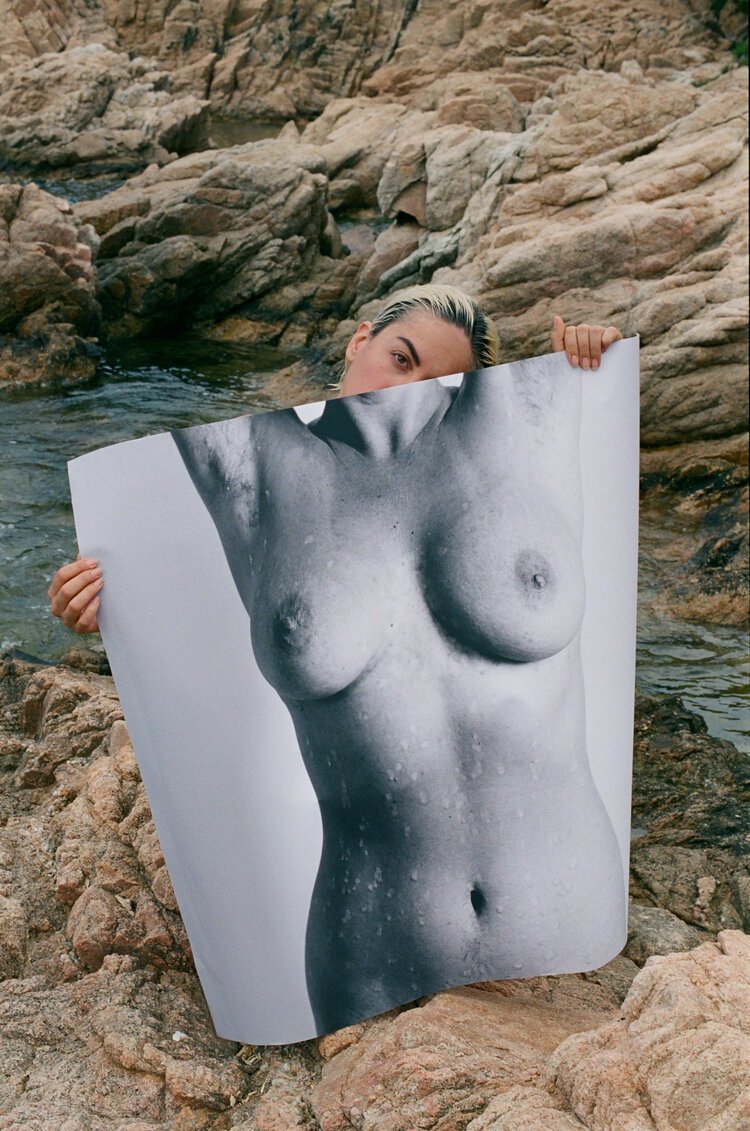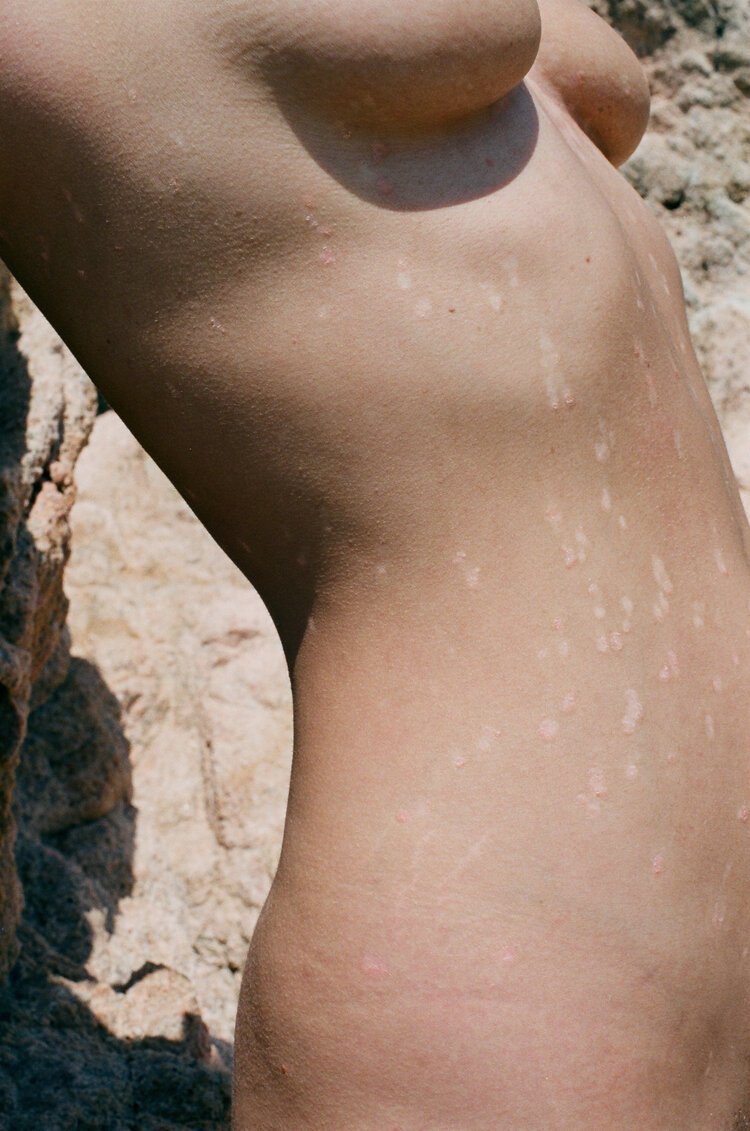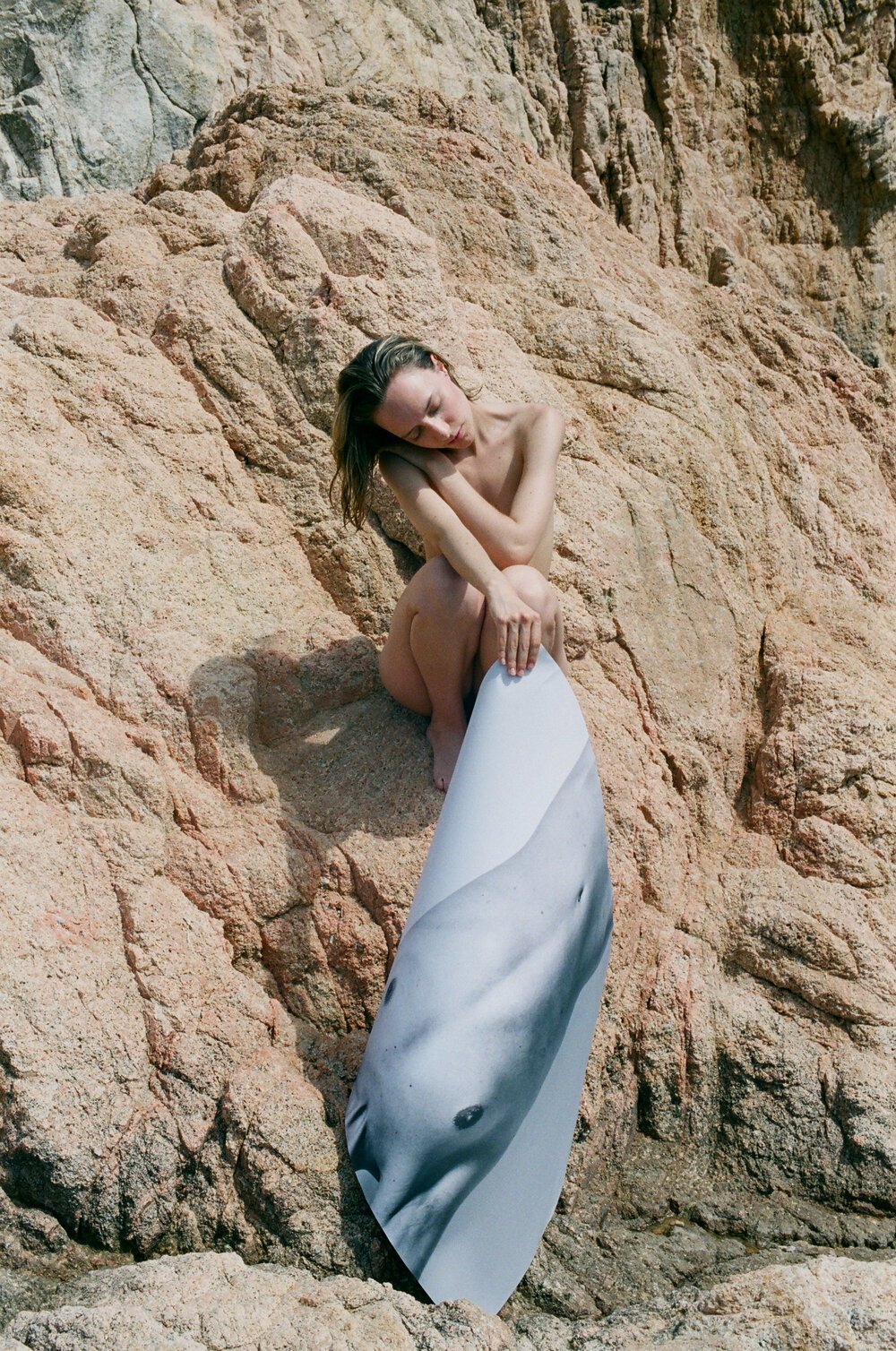In the US alone, 40 million people have psoriasis and eczema. Globally, the two skin conditions affect a population greater than North America. A new photography project is starting a conversation for that community around the process of diagnosis and what comes after.
“I want to talk about the medical experience of living with psoriasis and eczema,” says Miriam Thom, founder of club psora, a lifestyle platform for people with skin conditions. She’s at the helm of the skin-positive art series by Barcelona-based photographer Denisse Pérez, entitled The breaking of a wave cannot explain the whole sea. For the series (named from a quote by Vladimir Nabokov), Thom commissioned Pérez to capture skin advocate Sofia Suarez and one of her skin-sensitive friends in a rocky inlet off the coast of Spain. The two are pictured holding black-and-white clinical images of themselves, blown up and partially covering their nude bodies.
“They’re holding images that represent the standard clinical experience of having a skin condition,” says Thom. “What’s behind those images are their whole selves. Psoriasis and eczema are considered autoimmune in nature and like many other chronic illnesses, their root causes are not completely understood. This coupled with gaps in the healthcare industry have left so many of us feeling isolated and out of touch with our conditions, annexed by a veil of mystery. That’s the gap we’re pointing to in these photographs. We need so much more than the black-and-white prognosis of having an incurable disease — especially when skin conditions can be so substantially impacted by things like diet, stress and lifestyle. What’s behind this black-and-white diagnosis are unique living bodies. There’s so much we can do day-to-day to support our skin. But we need much more than a 15-minute doctor’s appointment to understand what those things are.”
Meanwhile, the photographs’ oceanic backdrop creates a powerful metaphor about complexity and resilience that Thom feels strongly relates to living with a skin condition.
“Our symptoms — skin flares that can be extremely severe — are like the waves crashing into this rocky terrain. Out of context, it’s pure chaos and turmoil. A skin condition can feel like that; many people say it feels like having no control over your body. But if you sit with the waves, you realize they’re part of a larger whole, the ocean. If you study them, you start to see patterns in how they behave depending on the time of the month, the weather, the season. Our skin is like that too.”
Thom collaborated with Saurez (known on her Instagram as @isdermis) on the concept for the series. The two often use their platforms to discuss self-acceptance in a society where skin conditions continue to be stigmatized.
“When I looked at Sofia’s feed,” says Thom, “it was the first time I saw psoriasis as something beautiful and inherently human. She also captured so much of the vulnerability I was experiencing about having a skin condition. At the time I was in a place of deep shame, but Sofia projected a vision of self-love I found hopeful.”
Saurez says that this project was an opportunity to reflect on her own clinical experience with psoriasis.
“I was diagnosed when I was 8 years old,” she recalls, “and I can so clearly remember leaving the doctor’s office and asking my mother what "chronic" meant — a word the dermatologist had repeated. It is something that will always be, she’d said. I wanted to remove each of the spots and wounds that had appeared all over my body. This doctor had just told me I would have them for my whole life.”
Thom explains that in fostering community among skin-sensitive individuals through club psora, she realized that so many people were showing up with stories like this.
“My experience was not dissimilar to what so many people go through when they’re dealing with the onset of an autoimmune condition. I had my first outbreak late in life, just before my 30th birthday. Overnight an itchy, red rash covered essentially my entire body. I spent months going from doctor to doctor and was misdiagnosed three times before a biopsy confirmed severe guttate, inverse, and scalp psoriasis. I was told there was no cure and I would learn to manage my condition through medication. I went home and googled “psoriasis” and faceless body parts covered in severe plaques and lesions popped up all over the screen. I had never felt more alone.
By the time I actually got a diagnosis, my psoriasis had completely taken over my life. I would have taken any drug to relieve my symptoms but I couldn’t afford the stronger topical I’d been prescribed — a two-week supply would cost me about half a month’s rent, even with my insurance. I started looking into other options and realized that prescription and over-the-counter medications only treated the symptoms of a skin condition, not the root cause. I found few resources for reversing psoriatic conditions naturally — although rigorous research suggested it was possible. club psora was born at that time in my life. I wanted to create a space with information about these conditions and a community to empower and motivate each other.”
Now in remission for more than a year, Thom is focused on helping others find the best ways to support their skin and heal. She says the goal of club psora and projects like The breaking of a wave cannot explain the whole sea, is to elevate the stories of the community and inform those less likely to know about holistic approaches.
“Our mission is to provide options and resources additional to the clinical experience so when someone is diagnosed or goes looking for answers, they’re met with hope. We want this demographic to know that there’s a community of people all working to understand their condition and live in a way that’s more supportive of their skin. That starts with finding your strength — with regaining the sense of control so many of us feel we’ve lost through prognosis and treatment. In these photographs, you see this rocky backdrop perpetually pounded by the ocean’s waves. It’s a living symbol of resilience. I want a community where you’re not seen as suffering because you have a skin condition. Instead, you’re seen for your strength — that’s the natural side effect of living with a chronic illness like ours.”











